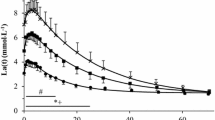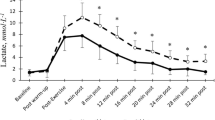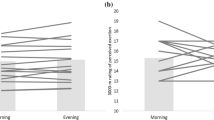Abstract
This study examined whether circadian rhythms affect lactate threshold (Thlac) during rowing exercise. Eleven male, endurance-trained athletes [mean (SD) age 29.5 (6.1) years] rowed at 0200, 0600, 1000, 1400, 1800 and 2200 hours under the same experimental conditions. Capillary blood (25 μl) was obtained from the tip of the toe during the last 30 s of a continuous, multi-stage, 3-min, incremental protocol on the Concept II ergometer. To determine Thlac, a curve-fitting procedure (the D max method), a visual method (Thlac-vis) and the fixed blood lactate concentration of 4.0 mmol l−1 (Thlac-4 mM) were used. Circadian rhythms were apparent for oxygen consumption and heart rate at Thlac using the D max method (P=0.02 and P=0.04 respectively), with the acrophases at 2139 hours and 2032 hours respectively coinciding in phase with that of core body temperature. The conclusion is that tests should be completed at the same time of day at which the athlete usually trains, to ensure precision of Thlac determination, especially when the D max method is used to determine Thlac.


Similar content being viewed by others
References
Åkerstedt T (1979) Altered sleep/wake patterns and circadian rhythms. Acta Physiol Scand Suppl 469:1–48
Bland JM, Altman DG (1986) Statistical methods for assessing agreement between two methods of clinical measurement. Lancet i:307–310
Borg G (1970) Perceived exertion as an indicator of somatic stress. Scand J Rehab Med 2–3:92–98.
Burgoon PW, Holland GJ, Loy SF, Vincent WJ (1992) A comparison of morning and evening “types” during maximum exercise. J Appl Sport Sci Res 6:115–119
Cheng B, Kuipers H, Snyder AC, Keizer HA, Jeukendrup A, Hesselink M (1992) A new approach for the determination of ventilatory and lactate thresholds. Int J Sports Med 13:518–522
Dalton B, McNaughton L, Davoren B (1997) Circadian rhythms have no effect on cycling performance. Int J Sports Med 18:538–542
Deschenes MR, Sharma JV, Brittingham KT, Casa DJ, Armstrong LE, Maresh CM (1998) Chronobiological effects on exercise performance and selected physiological responses. Eur J Appl Physiol 77:249–256
Forsyth JJ, Farrally MF (2000) A comparison of lactate concentration in plasma collected from the toe, ear and fingertip after a simulated rowing exercise. Br J Sports Med 34:35–38
Forsyth JJ, Reilly T (2003) A rowing protocol to determine lactate threshold. In: Reilly T, Marfell-Jones M (eds) Kinanthropometry VIII. Routledge, London, pp 55–65
Giacomoni M, Benard T, Gavarry O, Altare S, Fulgairette G (1999) Dirunal variations in ventilatory and cardiorespiratory responses to submaximal treadmill exercise in females. Eur J Appl Physiol 80:591–597
Hill DW, Cureton KJ, Collins MA, Grisham SC (1988) Effect of the circadian rhythm in body temperature on oxygen uptake. J Sports Med Phys Fitness 28:310–312
Horne JA, Östberg O (1976) A self-assessment questionnaire to determine morningness-eveningness in human circadian rhythms. Int J Chronobiol 4:97–110
Hughes EF, Turner SC, Brooks GA (1982) Effects of glycogen depletion and pedalling speed on anaerobic threshold. J Appl Physiol 52:1598–1607
Ingham SA, Whyte GP, Jones K, Nevill AM (2002) Determinants of 2,000 m rowing ergometer performance in elite rowers. Eur J Appl Physiol 88:243–246
Marti B, Zundel R, Held T (1998) Beeinflusst ein früher vs. später vormittäglicher Testzeitpunkt die Ergebnisse eines Ausdauerleistungstests? Schweiz Z Sportmed Sporttraumatol 46:155–158
Mazzeo RS, Marshall P (1989) Influence of plasma catecholamines on the lactate threshold during graded exercise. J Appl Physiol 67:1319–1322
Minors DS, Waterhouse JM (1981) Circadian rhythms and the human. Wright, Bristol
Mullineaux PR, Bartlett RM, Bennett S (2001) Research design and statistics in biomechanics and motor control. J Sports Sci 19:739–760
Nelson W, Tong YL, Lee JK, Halberg F (1979) Methods for cosinor rhythmometry. Chronobiologia 6:305–323
Reilly T, Brooks GA (1982) Investigation of circadian rhythms in metabolic responses to exercise. Ergonomics 25:1093–1107
Reilly T, Deykin T (1983) Effects of partial sleep loss on subjective states, psychomotor and physical performance tasks. J Hum Mov Stud 9:157
Reilly T, Robinson G, Minors DS (1984) Some circulatory response to exercise at different times of day. Med Sci Sports Exerc 16:477–482
Schlierf G (1978) Diurnal variations in plasma substrate concentration. Eur J Clin Invest 8:59–60
Sekir U, Ozyener F, Gur H (2002) Effect of time of day on the relationship between lactate and ventilatory thresholds: a brief report. J Sports Sci Med 1:136–140
Stegmann H, Kindermann W, Schnabel A (1981) Lactate kinetics and individual anaerobic threshold. Int J Sports Med 2:160–165
Stephenson LA, Kolka MA, Francesconi R, Gonzalez RR (1989) Circadian variations in plasma renin activity, catecholamines and aldosterone during exercise in women. Eur J Appl Physiol 58:756–764
Yeh MP, Gardner RM, Adams TD, Yanowitz FG, Crapo RO (1983) “Anaerobic threshold”; problems of determination and validation. J Appl Physiol 55:1178–1186
Yoshida T (1984) Effect of exercise duration during incremental exercise on the determination of anaerobic threshold and the onset of blood lactate accumulation. Eur J Appl Physiol 53:196–199
Acknowledgement
The time and effort of the subjects who participated in this investigation are greatly appreciated.
Author information
Authors and Affiliations
Corresponding author
Rights and permissions
About this article
Cite this article
Forsyth, J.J., Reilly, T. Circadian rhythms in blood lactate concentration during incremental ergometer rowing. Eur J Appl Physiol 92, 69–74 (2004). https://doi.org/10.1007/s00421-004-1059-8
Accepted:
Published:
Issue Date:
DOI: https://doi.org/10.1007/s00421-004-1059-8




